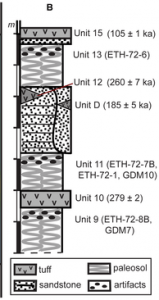In a recent article at PLOS ONE (November 13, 2013), researchers describe hafted projectile points found in Ethiopia that date to approximately 279,000 years ago.
This is important because, until now, direct evidence for this type of projectile was dated only to about 80,000 years ago. Modern humans have been dated to as far back as about 195,000 years ago (at Omo National Park also in Ethiopia), so this either puts H. sapiens back another 80,000 years or puts projectiles in the hands of an earlier hominid species. Or the interpretation of the artifacts is wrong. Or the dating is wrong.

doi:10.1371/journal.pone.0078092.g001
With regard to the dating, it seems solid. Argon-argon dating was used, putting the oldest artifacts at excavation units ETH-72-8B and GDM7 to at least 279 ka.
The artifacts were interpreted as “javelin” points due to the way they’ve been fractured. They’re clearly worked points for hafting, so the question then becomes are these hafted points then used for thrusting or throwing? By doing experimental work, archaeologists have been able to determine the impact velocities that hafted points reach when thrusted or thrown. These velocities are very different and, thus, give different fracture patterns. The patterns associated with the artifacts found under Unit 10 in ETH-72-8B and GDM7 show that they were thrown.
So that leaves who threw them. Personally, I don’t think it’s a stretch to say that H. sapiens were mixing it up with the wildlife in Ethiopia 80,000 years earlier than we previously thought. But I also think the line between modern H. sapiens and earlier hominin species is probably more blurred than we think, particularly with regards to behavior and social interactions. The real news here isn’t that humans are older than we thought (I think that is a fact many expected), rather it’s that humans were thinking complex thoughts and trading ideas much earlier than we give them (us?) credit for.
The dating seems okay, but you should examine the fracture velocity data carefully. You will see that the better fit for the range of velocities recorded for the Gademotta points is the range of velocities associated with hard hammer percussion. There is no actual support in the data for these pieces having been javelin points, despite the assertion in the paper (I understand that not all the authors supported Salhe’s interpretation of the data). Micro wear suggests they were hafted, but this does not necessarily mean they were anything more than knives.